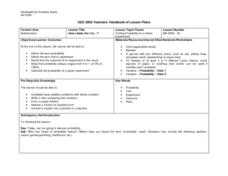Curated OER
Youth Gambling Addiction
Students demonstrate how to say no to gambling. In this addiction prevention lesson, students define gambling and categories of gamblers, then practice saying no to gambling. Then, students work in small groups to role-play a gambling...
Curated OER
Solving Math Problems In the Real World
Upper elementary and middles schoolers discuss and solve real world applications of math. They use formulas for volume and percents to answer real world questions. In the second part of the activity, groups write and solve word problems....
Curated OER
The Gambling Problem
In this gambling worksheet, students determine the amount two people made while gambling in Atlantic City. They identify and compute a factorial and a number squared. This one-page problem contains 1 problem. This problem would be...
Curated OER
A Potful of Probability
In this probability worksheet, students complete word problems dealing with marbles, sports, gambling, and more. Students complete 6 problems total.
Curated OER
Probability and Statistics Pre-Test
In this statistics and probability interactive worksheet, students answer ten multiple choice questions by applying the principles of probability.
Curated OER
What is Common Sense?
In this self-assessment activity, students brainstorm a list of 10 common sense things to do to remain gambling-free after reading a brief description of what common sense is.
Curated OER
Probability
In this Algebra II learning exercise, 11th graders compare and contrast experimental probability and theoretical probability. The two page learning exercise contains explanation of topic, worked examples, and seven practice problems....
Curated OER
Cartoons for the Classroom: Great Expectations
Learners can use this worksheet to discuss the expectations placed on the Obama presidency. Included are two cartoons to analyze, a web site to visit, several great discussion questions, and a short activity. This is one worksheet that...
PBS
Stories of Painkiller Addiction: Contemplating Nature vs. Nurture
Does having an addict in your family make it more likely to become one yourself? Explore the genetic risk factors, as well as the prominent environmental influences, for substance addiction in a lesson that encourages awareness and open...
Curated OER
Create a Walking Tour of San Francisco's Chinatown
Take a tour of Chinatown as it was in the 1800's. Analyzing primary source images and documents, learners will gain a better understanding of the myths and misconceptions of Chinese immigrants during the 1800's. They create a pamphlet to...
101 Questions
100-Hand Video Poker
You hit the jackpot with a fun lesson! Peak your pupils' interest with a lesson calculating the probability of poker hands. A video shows the different types of possible hands when given a specific hand and one card to draw.
Curated OER
Cartoons for the Classroom: Great Expectations
In this current events activity, learners analyze a political cartoon about the Obama presidency and respond to 3 talking point questions.
Curated OER
Roulette
Students participate in a simulation activity to help them summarize issues related to health promotion and disease prevention. They see first-hand what their odds are in acquiring HIV.
Curated OER
Risk Taking Behaviors
Tenth graders listen to a presenters introduction and write questions they hope to have answered during the presentation. They listen to a presentation and record notes. They participate in small group discussion and complete...
Curated OER
Probability: How Likely Am I to...?
Twelfth graders examine various ways probability is applied to daily situations. They use marbles and blocks to calculate the probabilities of picking certain colors. They also calculate the odds of picking a winning raffle ticket.
Curated OER
Management and Leadership
Pupils undertake the study of leadership theory. The skills of being a leader and manager are covered. There is a comprehensive use of real life examples throughout the lesson.
Council for Economic Education
Econ Ed Link: Money Doesn't Grow on Trees
This lesson plan helps students distinguish between earned and unearned income by identifying methods for getting money.


















